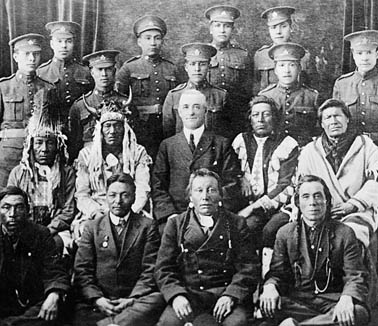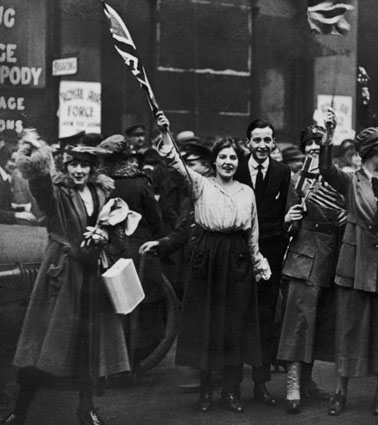Happy 100 First World War Armistice .. a view from the northern woods ..
Nov 11th, 2018 | By Citizen X | Category: In Brief
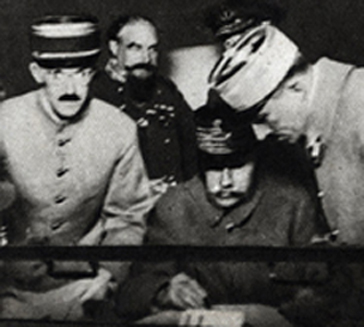
“Le maréchal Ferdinand Foch (1851-1929) lors de la signature de l'Armistice dans un wagon du train d'état-major appelé le "wagon de l'Armistice", dans la clairière de Rethondes, en forêt de Compiegne. © Pèlerin”
The site administration staff have told me that I’ve already contributed at least one (as we say in Canada) Remembrance Day piece back in the past (“O valiant [Toronto] hearts who to your glory came .. your memory hallowed in the land you loved,” on November 11, 2013).
They’ve pointed out as well a still earlier related piece by my esteemed colleague L. Frank Bunting (“Afghanistan agony haunts November 11, 2010”).
This November 11, 2018 marks the 100th anniversary of the signing of the armistice that ended the First World War (aka at the time the Great War) – “dans le wagon-salon du maréchal Foch, à Rethondes dans la forêt de Compiègne.”
And – Bunting being otherwise occupied at his almost winterized wilderness retreat in the Kawarthas (or is it Haliburton?) – I have been asked by the managing editor here to share some further thoughts on the present-day meaning of the end of the First World War. (Or “First German War” as the old-school English historian George Clark called it, in his masterful 1971 summary English History : A Survey.)
I want to start with a few background notes. The Veterans Affairs Canada website, eg, has a helpful synopsis : “The armistice of November 11, 1918, brought relief to the whole world … Sixty-five million men from 30 nations were involved in” the war ; “at least ten million men were killed; twenty-nine million more were wounded, captured or missing.”
Starting in the summer of 1914, the war “was also a landmark in Canadian national development … Canada entered the war as a colony, a mere extension of Britain overseas.” At the end, for a place “of eight million people Canada’s war effort was remarkable. Over 650,000 Canadian men and women served in uniform … with more than 66,000 giving their lives and over 172,000 more being wounded … It was this …that won for Canada a separate signature on the Peace Treaty.”
This Peace Treaty was not signed until June 28, 1919. The Armistice signed on November 11, 1918 just marked the end of fighting. It would take another six months to negotiate a formal treaty of peace among all participants.
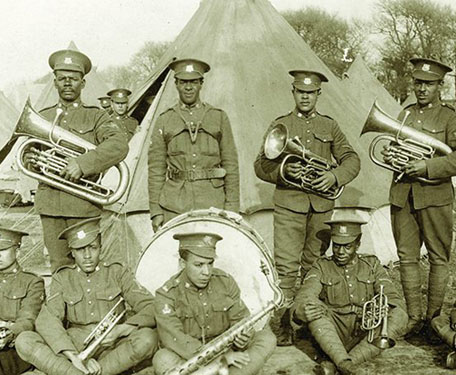
Our best guess is that this is the band of Canada’s No. 2 Construction Battalion, which “sailed from Halifax Harbour to England, and then to France, where they served with the Canadian Forestry Corps during the First World War.”
It took some time to negotiate even the November 11 Armistice. The process began when the German government sent a message to US President Woodrow Wilson early in October 1918, proposing negotiations for peace on the basis of his “Fourteen Points.”
The Americans had only joined the war, however, in April 1917. The supreme commander of “the Allies” fighting Germany and its allies was the Marshal of France, Ferdinand Foch. And the November 11 Armistice was (as noted above in Canada’s other official language) finally signed in a railway car “given to Ferdinand Foch for military use by the manufacturer, Compagnie Internationale des Wagons-Lits,”
Foch’s railway car was parked near a station at Rethondes, in the forest around the nearby larger urban centre of Compiègne in northeastern France. For the Allies the November 11 Armistice document was signed by Supreme Commander Foch and the British First Sea Lord Admiral Rossyln Wemyss, representing Allied naval forces. Four men signed for Germany – Matthias Erzberger, representing the German government, and envoys from the German foreign ministry, army, and navy.
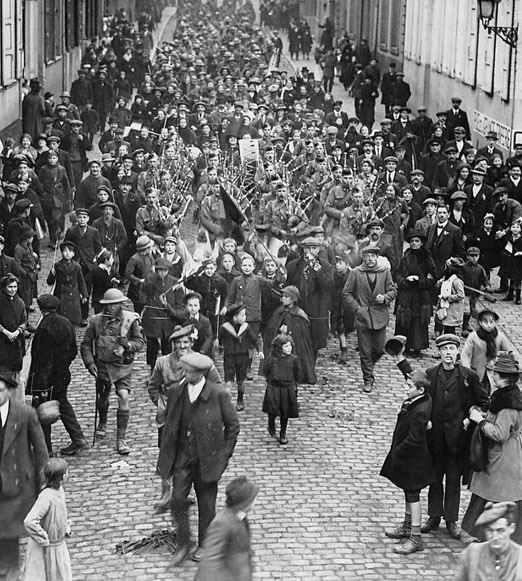
Canadians – more exactly Montreal’s Black Watch regiment – marching through Mons, warmly received by liberated Belgians, November 11, 1918.
No Canadians (or Americans for that matter) actually signed the 1918 Armistice. But there is a serious Canadian wrinkle on November 11. After some deliberation I have decided my own best source here is A.J.P. Taylor’s English History, 1914—1945.
Taylor notes that when the 1918 Armistice came into force, at 11 AM GMT on November 11, “German troops” were still for the most part “everywhere on foreign soil.” Yet, happily enough, “Canadian forces entered Mons [in German-occupied Belgium] about an hour before the armistice and thus, appropriately, ended the war where the ‘old contemptibles’ had begun it” (at the Battle of Mons between British and German forces, on August 23, 1914).
In his 1983 volume of memoirs entitled A Personal History, A.J.P. Taylor noted that when he was commissioned to write English History, 1914—1945, as part of the Oxford History of England, he had to make certain decisions : “I was not interested in writing the history of the English upper classes which is what English history usually amounts to. Maybe the English people had no history until fairly recently. In the twentieth century they had, and that is what my book is about. I was glad when [critic and reviewer] Max Beloff described it as Populist history.”
At a now considerably later time when “populism” has become a much-abused term, too often used to describe a right-wing political pathology that real (and left-wing) populists like the late A.J.P. Taylor would find abhorrent, it seems appropriate to end my own reflections here with Taylor’s account of what happened (in his country at any rate!) right after the 1918 Armistice was signed. (As a mark, whatever else, of just what “Populist history” can involve.)
I quote the late great man’s entire and admirably lean paragraph at the bottom of p. 113 and top of p. 114 in the 1970 paperback update of the 1965 first publication of English History, 1914—1945 :
“In the fighting-lines there was bewildered relief when the guns ceased to fire. There was no fraternization and little rejoicing. In England people were less restrained. Work ceased in shops and offices, as news of the armistice spread. Crowds surged through the streets, often led by airmen and Dominion troops on leave. Omnibuses were seized, and people in strange garments caroused on the open upper deck. A bonfire heaped against the plinth of Nelson’s column in Trafalgar Square has left its mark to this day. Total strangers copulated in doorways and on the pavements. They were asserting the triumph of life over death. The celebrations ran on with increasing wildness for three days, when the police finally intervened and restored order.”
